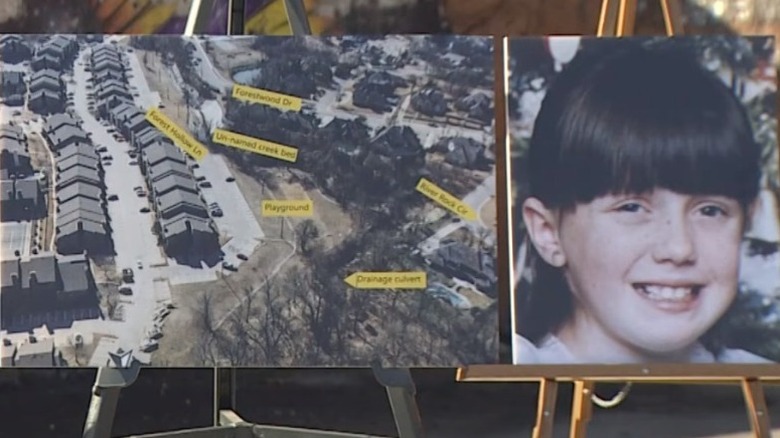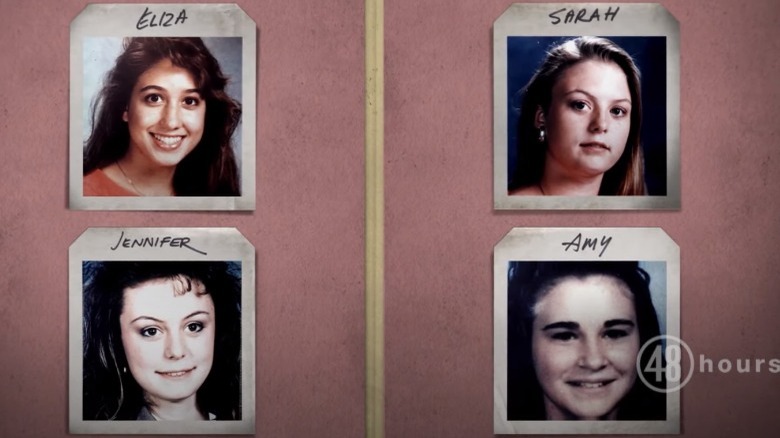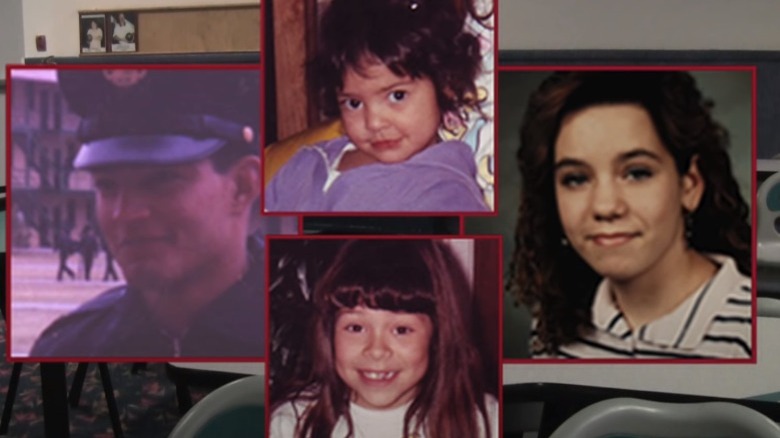The Biggest Unsolved Mysteries Of The 1990s
The 1990s were an undeniably cool time to grow up. Things might have seemed a little safer than the lawlessness and chaos of childhood in the 1980s, but it was still a time when cell phones and constant connectivity weren't really a thing yet, and Netflix? There was no spending long afternoons binge-watching anything, it was a matter of ordering DVDs and then waiting for them to show up in the mail.
They were different times.
Things were changing in the world, and during the 1990s, there were a series of high-profile crimes that forever changed the way parents raised their children. Some ended in arrests and justice, others went unsolved, and they all captured the attention of the nation. The Golden Age of Serial Killers may have been fading, but the thing about the '90s is that suddenly, kids and teens were seeing a lot of faces on the news that looked their own age. Not everyone's story had a happy ending: Let's talk about the biggest cases of the '90s that remain unsolved even decades later. Who knows — maybe someone out there has the key.
Who killed Amber Hagerman?
Amber Hagerman was nine years old in 1996, and as she rode her bike in the parking lot of a grocery store just a stone's throw from her grandmother's home, she would have had no idea that her life was about to come to a tragic end. A single witness came forward, saying that they had seen someone driving a truck grab Hagerman off her bike. Police in the local Arlington, Texas police department were on high alert, coverage of her kidnapping was covered by national media outlets, and in the end, it didn't matter. Her body was recovered four days later: She had been killed and dumped in a creek.
In 2021, police issued another appeal for new information, and KIRO 7 news reported that there still might be a good chance for justice: Police had DNA from the cold case and were going to be making yet another attempt to take advantage of new technologies to try to find a match.
As tragic as Hagerman's disappearance and death were, there has been a considerable amount of good that has come from it. After her murder, broadcasters and law enforcement worked together to create the AMBER Alert System. In addition to being adopted across the U.S., the AMBER Alert System is also in use in Europe, where 18 countries use it to notify the public of missing or kidnapped children. Thankfully, 1,111 children have been rescued thanks to the alert system (as of December 31, 2021).
Who organized the Isabella Stewart Gardner Museum heist?
The theft that the Smithsonian calls "the biggest art heist in modern history" happened on March 18, 1990. In just 81 minutes, two people walked into the Isabella Stewart Gardner Museum, restrained the two guards on duty, and stole around $500 million worth of art (at today's value). One piece alone — one of only about 34 surviving paintings by Johannes Vermeer — was worth a whopping $250 million. Other stolen works included Rembrandt's Christ in the Storm on the Sea of Galilee, a few other Rembrandts, some sketches by Edgar Degas, and strangest of all? The museum's most valuable painting — by Titian — was left behind.
In spite of the fact that the museum continues to offer a $10 million reward to anyone who comes forward with information that helps them recover the paintings, not a single work has yet been recovered. Clues, however, are still lingering. In 2021, NBC Boston reported that a then-local jeweler had come forward with testimony that one long-time suspect, Bobby Donati, had approached him with one of the pieces stolen in the heist.
That report came on the heels of the death of another suspect, Robert Gentile. Gentile had connections with the mob but always denied that he had anything to do with the theft. The museum has never removed the empty frames where the 13 stolen pieces once hung, and they remain as a reminder of one of the decade's biggest mysteries.
Did Finland have a serial killer?
Serial killers are a phenomenon that's not as widespread as it might seem. The U.S. has the most by far, and there are plenty of countries that have never had any. There's one country that claims to have never had a serial killer prowling among them, but a series of unsolved murders in the early 1990s means that may or may not be the case. The country in question is Finland, and according to MTV UUTISET, the Central Criminal Police maintain that there has never been a serial killer in Finland. But, some say the body found at the Hausjarvi sandpit was, indeed, the work of a serial murderer.
For a long time, it was believed that the first attack came in November of 1990. A young woman was offered a ride, drugged, and attacked, but managed to escape. Fast forward to the following spring, and the body of a 28-year-old woman was discovered in the sand pits at Hausjarvi. Two years later, another dark-haired woman of about the same age was offered a ride from a restaurant in the same area. She was never seen again.
In 2017, the media reported that law enforcement had come forward with a fourth case dating back to 1989. The victim fit the profile, was offered a ride and alcohol by a man who seemed intoxicated, and had also escaped. (She hadn't reported the incident at the time.) Are there more victims? No one knows.
Who killed the teens at the yogurt shop?
On December 6, 1991, emergency responders rushed to put out a fire in a yogurt shop in Austin, Texas. Once the flames were out, they were shocked by what they saw: the remains of four girls. The teenagers had been tied up, shot, and left in the building as it was set on fire. Any evidence that may have been left behind was destroyed in the blaze, and investigations led nowhere ... until, says The Austin American-Statesman, four men were arrested. That didn't happen until 1999, and although the men confessed, they later said they were innocent, and had only confessed under interrogation. The two who had been convicted had those convictions overturned on appeal, and the case remains unsolved.
Law enforcement believed from the beginning that multiple people were involved in the murders of 13-year-old Amy Ayers, 15-year-old Sarah Harbison, and 17-year-olds Jennifer Harbison and Eliza Thomas. Leads came and fizzled, and the case dragged on. Still, there's a chance that this may be solved someday.
In early 2022, CBS News reported that one of the victims had been sexually assaulted, and the fire hadn't destroyed one single piece of DNA evidence. Recovered along with the rounds from the weapons used, the hope is that advances in DNA technology will allow law enforcement to finally get a match on the DNA, and bring the killers to justice.
What happened to the Frog Boys?
The Netflix documentary "In Search of the Frog Boys" is based on real events that took place on March 26, 1991. That, reports Channel News Asia, is when five boys went out to look for salamander eggs, and never came home. The five boys were all between the ages of 9 and 13, and when their parents reported them missing to South Korean law enforcement, officers were quick to decide that the five had simply decided to run away.
The families — who were all extremely close — knew that wasn't the case at all, and on the fourth day the boys were missing, they received a phone call. The voice told them: "I have the children. They're all suffering. Two are very ill." The caller then demanded a ransom, set up a meet, and then never showed up at the designated time and place.
The families continued to get brushed off by law enforcement, and attempts at getting media coverage proved difficult, as everyone was more concerned about the imminent elections. It was nearly a week before the media picked up on the story, and once they did, it quickly grew into the nation's biggest, most widely-publicized missing persons' case. Thanks to public outcry, thousands joined the search efforts, but it took 11 years before the remains of the boys were discovered on the side of a nearby mountain. No cause of death was ever determined, but many are convinced the five boys were murdered.
What did the children of Ariel School really see?
So here's a weird one: According to the BBC, it was Sept. 12, 1994, when a group of 60 children returned to their school in Ruwa, Zimbabwe, each telling a strange story. Each one was convinced they had seen a "large, brightly colored object" land in a clump of trees, and alien figures were standing around the craft. Teachers asked the kids to all independently draw what they had seen, and they did: After all drawing incredibly similar pictures of the craft and the creatures, teachers came to the conclusion that yes, they had seen something ... but what?
The story gets stranger, as more and more people across southern Africa saw a similar craft, and described much the same thing the schoolchildren had drawn. The story was widespread and strange enough that it attracted experts from all over the world, including Harvard psychiatrist John E. Mack. He headed to Zimbabwe after the incident occurred, and based on the accounts the children shared with him, he came to the conclusion that it wasn't mass hysteria, and they had seen some sort of mysterious craft. Cambridge's John E. Mack Institute maintains (via the Boston Herald): "Something strange happened to the group of children that left them with the impression some form of sentient life cared about the Earth and ... cared about the children."
While skeptics say it was simply a well-executed prank, others aren't so sure.
Who killed Tupac Shakur?
In 2021, the Las Vegas Review-Journal marked the 25th anniversary of the murder of Tupac Shakur with a deep-dive into what was known about his last night. It was right after Mike Tyson put an end to a fight in 109 seconds that Shakur was caught on camera for what would be the last time. He was walking through the MGM Grand when he saw a gang member that had a previous altercation with one of his Death Row Records associates, and the following fight was over quickly. Shakur walked away, and was shot two hours later, as he sat at a stoplight.
Shakur died six days later of four gunshot wounds, and no one was ever arrested. There are a ton of theories about just what went down that night, and as the journalist, filmmaker, and producer of the series "Who Killed Tupac?" Stephanie Frederic explained: There's too many dirty details, too many people who will come under fire, too many secrets that will probably get out, that shouldn't be out. There's so many entanglements."
And there were a ton of witnesses: Shakur was, at the time he was shot, sitting in a line of cars filled with what was described as his "Death Row entourage." While they all would have seen the white Cadillac and the shooter, everyone has refused to talk. Law enforcement places the lack of arrests squarely on the shoulders of the silent witnesses, and the killing remains unsolved.
Who was behind the Loomis truck robbery?
It sounds like something that unfolds in the first few moments of a very unbelievable movie, but it's absolutely true.
On March 24, 1999, a Loomis truck left Sacramento loaded with cash. It was a typical sort of trailer, and SF Gate says that it was an unarmored version used for large pick-ups and drops. And that's actually important, because when the truck arrived at the end of the two-hour trip and the rear doors were opened, that was when they realized someone had cut a hole in the top of the truck and managed to steal $2.3 million in $20s, $50s, and $100s.
The truck — which had made a single stop along the way — bore only the slightest traces of a single thief: footprints, left behind as he climbed down the back of the trailer. Authorities also recovered a duffel bag from inside the truck, but the trail quickly went cold. A single witness was found, who said they had seen a man hop down from the roof, but aside from that, the money was never recovered and the thief walked away with 207 pounds of cold, hard cash. Loomis VP at the time, Mike Tawney, admitted: "Whoever did it, did an excellent job of planning."
What happened to the women of Ireland's Vanishing Triangle?
Between 1993 and 1998, women disappeared from an area of Ireland that was given the name of the "Vanishing Triangle." The points of the triangle were in the counties of Wexford, Louth, and Offaly, and within the bounds of those points, at least eight women vanished — some in broad daylight, says the Irish Independent — and were never seen or heard from again. Remains have never been discovered, and according to what writer Claire McGowan found when she wrote a book on the cold case, it's not even clear just how many women there are.
The usual number is eight, and their stories are varied. Deirdre Jacob, for example, vanished from just outside of her home, in the middle of the afternoon. Ciara Breen was 17 when she vanished one night, and Annie McCarrick was an American student last seen at a pub in the Dublin Mountains. McGowan found others that fit the same profile: 15-year-old Arlene Atkinson from Castlederg, for example. McGowan suspects a serial killer: "I have a hard time believing that each of these missing eight women was murdered by eight different men," she told The Irish Times. "I think some of them were done by the same person."
Without remains, though, that's made it tough to connect the victims or even start trying to compile suspect lists. There have never been any arrests or trials, but they haven't been forgotten.
Who organized the Father's Day bank massacre?
June 16, 1991, was like any other day at the United Bank Tower (pictured) in Denver, Colorado. Until, ABC Denver says, it wasn't. That was the day that an armed man went into the bank, shot and killed four security guards, and left with around $200,000 in cash.
The following year saw a massive trial broadcast across the nation. James King was a retired Denver police officer and had worked as a security guard at the bank before he was arrested for the killings and the theft. There were a lot of strong feelings around the trial, with some pointing to the fact that there was no actual evidence that it was him as a major red flag, while others were convinced that he was definitely the guy. King was ultimately acquitted, and until the Denver Post reported on his death in 2013, he remained under constant surveillance by the FBI, and under just as constant suspicion.
In 2021, the Toronto Sun did a refresher on the case and noted that there was still no official verdict. In spite of the evidence being circumstantial at best, law enforcement still claimed that the right guy had gone free — but not everyone was convinced.
Who killed JonBenét Ramsey?
It was 2021 when ABC Denver did a retrospective on the 25th anniversary of one of the highest-profile murder cases in the country: The death of 6-year-old JonBenét Ramsey.
Initially believed to be a kidnapping, police were called after Patsy Ramsey found a ransom note asking for $118,000 for her daughter's safe return. Police went to the house, hours went by — a full eight hours — and that's when one detective told Ramsey's father, John, to look around the house to see if he noticed anything odd. When he went into the basement, he found his daughter: She had been strangled, beaten, and wrapped in a blanket.
What followed was what could accurately be described as a media feeding frenzy, and the bottom line is that no one was ever brought to justice for the little girl's death. Rolling Stone outlined the list of suspects, and it was a long one that included both of her parents (who were officially exonerated), her older brother (who has maintained his innocence), a convicted sex offender and drifter named Gary Oliva (who was cleared with DNA evidence), a local electrician (who was also cleared on the basis of DNA), a teacher (who gave a confession ultimately deemed false), their housekeeper (with only circumstantial evidence pointing to her involvement), and a local man who dressed up as the town's Santa. The idea of his involvement was called "the sensationalized character assassination of a friendly old man," and JonBenét Ramsey's murder remains unsolved.
What were the Oakville blobs?
Not all unsolved mysteries involve murder, so let's look at one that's just downright weird. On Aug. 7, 1994, residents of Oakville, Washington woke to a strange sight. Overnight, weird, gelatinous blobs had fallen from the sky (maybe) and covered everything. They weren't just gross, reports the BBC's Science Focus, they were also dangerous. Residents blamed the blobs for the flu-like sickness that quickly started making the rounds. Doctors recorded higher-than-normal instances of inner ear problems, major respiratory problems, and vertigo in the days after the event: Some, like Beverly Roberts, suffered such bad vertigo that she had to crawl to her car to make it to the doctor. She was hospitalized for a week.
Even more disturbing were the deaths of any animals who happened to eat the jelly. They, reported The Chronicle, died almost immediately after ingesting the substance. Death came with vomiting green foam, and scores met this tragic fate.
There's never been a satisfactory explanation for what the jellies were, and yes, they've been analyzed. The results cleared up absolutely nothing, and the official results from the Washington Department of Health said that the blobs contained illness-causing bacteria (but, weirdly, none of the illnesses any of the victims suffered), along with white blood cells of human origin. No one has the foggiest idea what the heck was going on.
Who was the gunman at the Las Cruces Bowling Alley?
The Toronto Sun described the scene at the Las Cruces Bowling Alley as "a slaughterhouse," and it's dire stuff.
Employees were getting ready to open on Feb. 10, 1990, when two men forced their way in, and told the manager, Stephanie Senac, her 12-year-old daughter, and her daughter's 13-year-old friend to get on the floor. After another employee, Steve Teran, walked in with his 2- and 6-year-old daughters, the killing began. Teran and his daughters were killed instantly, and although Senac survived, she later died of complications. Amy Houser, 13, was also killed, says the Las Cruces Sun-News: In 2021, they were reporting on a documentary that had been released on the anniversary of the killing.
The two men left with somewhere around $5,000, and were never caught. Law enforcement — and the families of the victims — are still hopeful that they might be brought to justice someday, because while there was no DNA evidence recovered, there were plenty of fingerprints. Teran's brother, Anthony, is pretty sure they won't see justice: "I can almost guarantee that those two guys are dead. By their lifestyle, because if you can shoot a 6-year-old and a 2-year-old in the forehead, you can do anything. ... Nothing's going to bother you."
Who killed Andy the Goose?
A goose? Yes: Andy wasn't any ordinary goose. According to Atlas Obscura, Andy had been born without feet. His owner's husband was inspired by his determination to struggle along after his other geese friends and wanted to help. He outfitted the little goose with baby shoes, and Andy never looked back.
A local newspaper did a write-up, and the story went national. Andy was in magazines, on "The Tonight Show," and he even got a sponsorship from Nike. And kids? They loved him. When the Chicago Tribune reported on the flood of donations that poured in to help get justice for Andy, they also explained that the footless goose had become a role model for not only children but especially for disabled children.
Then, on Oct. 19, 1991, the goose's headless, wingless body was found in a local park (via the Associated Press). Local police called it "just a very senseless destruction of an animal," and Gene Fleming — who had made the boots for Andy in the first place — was devastated. Early signs of Alzheimer's appeared not long after he buried his beloved bird, and in the years following his own death, his daughter tried to figure out what happened to Andy. She was told someone had confessed, but the sheriff's department said: "We can't tell you, and we don't want to have any news release about it." As far as the children who so loved Andy are concerned, he never received justice.














